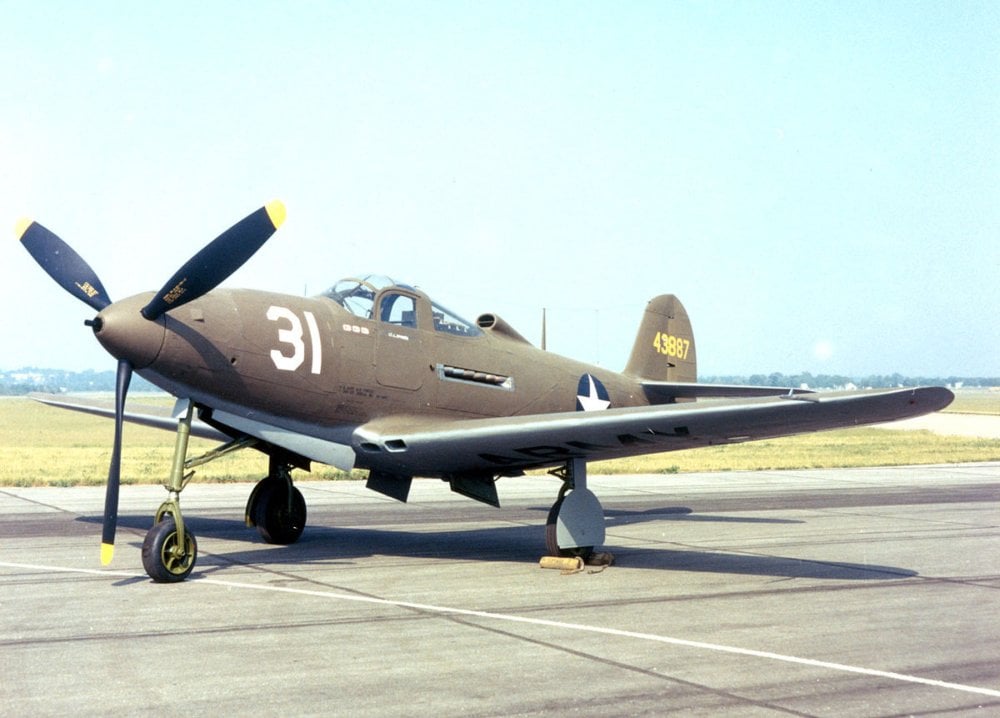The P-39
Perhaps one of the most maligned air craft of WWII, the Bell P-39 Aircobra was in many ways a fascinating design and unique aircraft. Some of the more outstanding features that many hated and some liked included the car door-like cockpit doors, the rear fuselage engine that sat behind the pilot in an awkward place causing the driveshaft to run beneath the pilots legs, and the 37mm cannon that shot through the front propeller. The tricycle landing gear was also unique as many of its contemporaries were tail draggers but other than a few front landing gear collapses no one complained of this feature.
The P-39 was doomed, however, by the Allison v-12 non supercharged engine that was to be its power plant. Although a supercharger was put in the original prototype engine, it was later taken out to improve aerodynamics thus robbing the aircraft of high altitude performance. It is of some note to consider that the P-51 had the same Allison non-supercharged engine when it first came out as well. It was not until the P-51 was fitted with the Merlin engine by the Brits that it became the top notch fighter of the war. So when the plane was rushed off to the Brits as a fighter, they quickly shipped it off to the Russians because it couldn't compete at high altitudes with German fighter planes. The Russians put it to good use as both a fighter and ground attack weapons platform but it never saw the notoriety that the P-51 or Spitfire did.
 |
| An American P-39 probably in New Guinea |
The Weapons
The P-39 was also unique when it came to armaments. The outstanding and probably most notable armament that it boasted was the 37mm cannon fired through the propeller. A cannon fired through the propeller was not new, the German Folke Wulf-190 had a nose cannon and so did the Bf-109. It was the size of the cannon that was impressive.
 |
| The Oldsmobile M4 37mm cannon |
 |
| 37mm installed in the nose of a P-39 |
The shells of the 37mm were so large that it was actually possible to watch them drop like an orange baseball after firing the cannon. It had a slow rate of fire but was deadly to large air planes or ships. Many pilots hated it because of the huge bullet drop: it was after all a low velocity shell, but against softer targets it was devastating. The plane also sported two .30 caliber machine guns fired through the propeller blades and two .50 caliber machine guns in wing roots. Many planes were refitted by the Brits and Russians to eliminate the 37mm cannon and replace it with a 20mm cannon. The Russians replaced the nose .30 caliber guns with two .50 machine guns as well. It seems the 37mm was left out in the cold except by the Americans who used it successfully as a ground attack weapon against the Japanese and on PT boats that scavenged the gun from P-39 wrecks on Guadalcanal. Eventually it was standard on the PT boats as a highly effective anti-shipping weapon.
 |
| A P-39 Firing all its weapons at once |
Sadly it was not to be the ultimate weapons platform that the U.S. Army wanted at the time. Even though an American pilot became an ace flying the P-39, Lt. Bill Fiedler who shot down three Japanese A6M Zero fighters in one battle with his P-39, rather it was the Russians who put this warbird to good use. One Russian pilot scored 53 kills with his P-39. It was the ideal weapon for the Russians due to the nature of how they were fighting the German army at the time. They put a bigger engine in it, eliminated the wing guns and were never given any ammo for the 37mm cannon so they installed two .50 cals in the nose and put extra ammo in it.
Final Thoughts on the P-39
While the P-39 was not the idea fighter for the Americans and certainly not the Brits, it is not the fault of the aircraft that it was not put to its proper use. It was never designed to be a high altitude interceptor, certainly not after the turbo charged supercharger was removed. Issues with flat spins and tumbles were documented due to the rear engine placement and the cannon in the nose: not a ringing endorsement for a front line fighter. It did however have a lot of things going for it. It had a high seated cockpit due to the driveshaft under the pilots feet. The great visibility was certainly helpful to ground attack missions and overall observation. The tricycle landing gear was a first. This landing gear allowed the plane to clear tough terrain in the jungles and was far safer than the typical taildragger arrangement. Most fighter aircraft come with tricycle landing gear now days so that is noteworthy. It is also important to note that the P-39 was ostensibly built around the 37mm cannon. This large weapon was primarily put on early WWII tanks as an anti-tank weapon. The 1 lb. bullet that it fired was particularly devastating when used on non hardened targets. There is perhaps another aircraft that has been designed in this manner: the A-10 Thunderbolt II. The A-10 has also been maligned and is under the same scrutiny as the P-39 was in WWII. It is thought to be outdated, redundant, and too old to accomplish modern day battlefield supremacy. However it was also designed around the 30mm cannon that takes up most of its fusalage. It is this weapon that has kept it, along with the extended loiter time it has, in the front lines as no other aircraft can compete with its firepower.

























